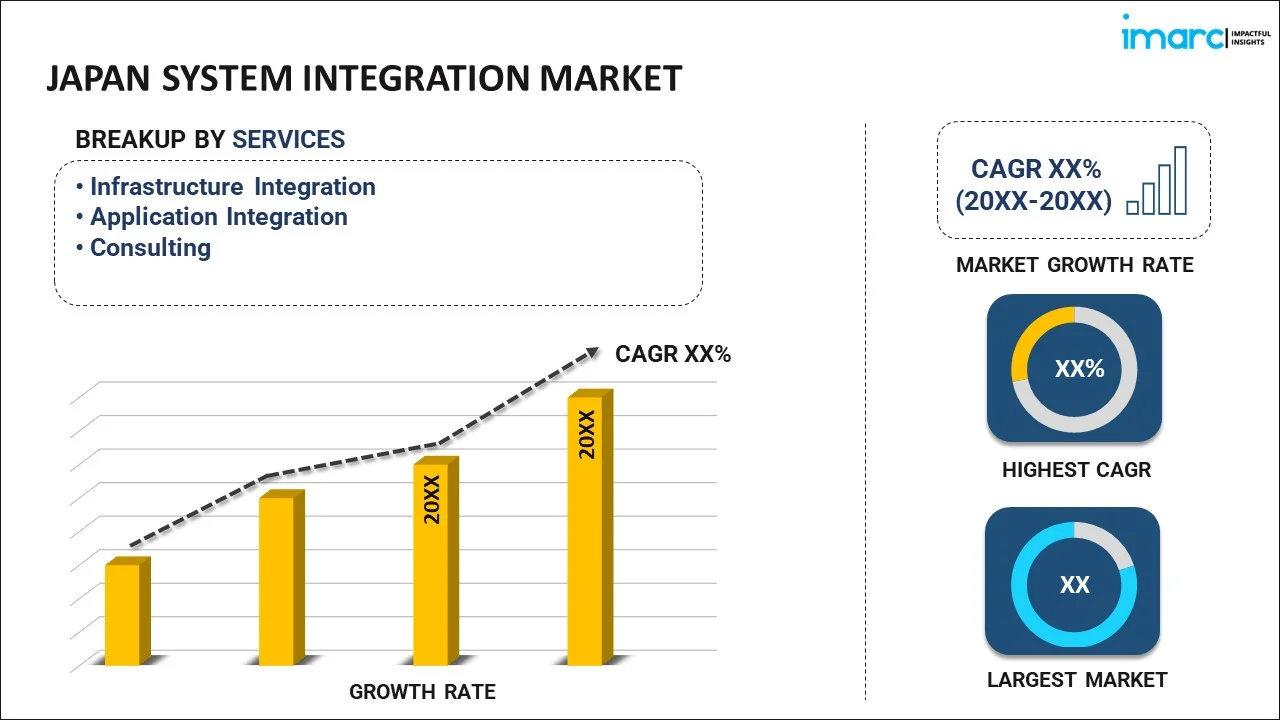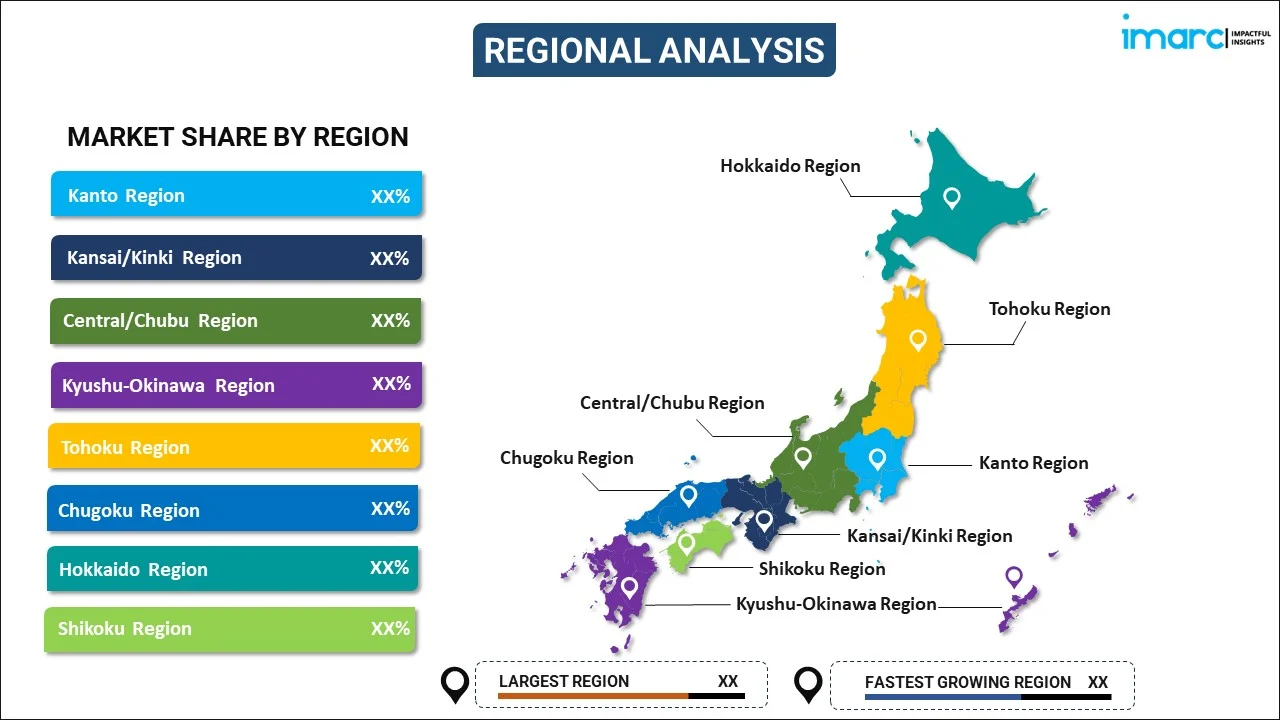
Japan System Integration Market Report by Service (Infrastructure Integration, Application Integration, Consulting), End Use Industry (BFSI, Government, Manufacturing, Telecommunications, Retail, Oil and Gas, Healthcare, and Others), and Region 2025-2033
Market Overview:
Japan system integration market size reached USD 32,941.2 Million in 2024. Looking forward, IMARC Group expects the market to reach USD 74,064.5 Million by 2033, exhibiting a growth rate (CAGR) of 8.95% during 2025-2033. The increasing utilization of cloud computing services, including Infrastructure as a Service (IaaS), Platform as a Service (PaaS), and Software as a Service (SaaS), along with the rising demand for system integration, is driving the market.
|
Report Attribute
|
Key Statistics
|
|---|---|
|
Base Year
|
2024
|
|
Forecast Years
|
2025-2033
|
|
Historical Years
|
2019-2024
|
|
Market Size in 2024
|
USD 32,941.2 Million |
|
Market Forecast in 2033
|
USD 74,064.5 Million |
| Market Growth Rate 2025-2033 | 8.95% |
System integration is the process of connecting different subsystems or components of a larger system so that they can work together seamlessly. It involves combining hardware, software, and often data from various sources to create a cohesive and efficient system. The goal of system integration is to ensure that all the parts of the system function as a unified whole, enabling efficient communication and data exchange between them. This process is crucial in modern technology-driven environments, as it allows organizations to optimize their operations, streamline processes, and improve decision-making. System integration can involve integrating different software applications, databases, hardware devices, and networks. It also encompasses the development of interfaces and protocols to facilitate communication between diverse components. Effective system integration can lead to increased efficiency, reduced redundancy, improved data accuracy, and enhanced overall performance. It is essential in various industries, including IT, manufacturing, healthcare, and finance, to achieve seamless operations and deliver better services to customers.
Japan System Integration Market Trends:
The system integration market in Japan is witnessing an unprecedented surge, primarily driven by the rapid advancements in technology and the growing complexity of business processes. Moreover, the increasing adoption of cloud computing and the Internet of Things (IoT) is significantly contributing to this trend as organizations seek efficient ways to consolidate their disparate systems. Furthermore, the need for real-time data analysis and the desire for streamlined operations are compelling businesses to invest in system integration solutions, thereby propelling the market forward. Additionally, the escalating demand for automation across various industry verticals is acting as a catalyst, urging companies to embrace integrated systems for enhanced productivity and decision-making. In conjunction with this, the quest for improved customer experience is another crucial driver, pushing organizations to integrate their systems to ensure a seamless flow of information and deliver superior services. Moreover, the proliferation of big data and analytics, which necessitates the amalgamation of diverse systems to facilitate effective data management and analysis, is expected to drive the system integration market in Japan during the forecast period.
Japan System Integration Market Segmentation:
IMARC Group provides an analysis of the key trends in each segment of the market, along with forecasts at the country level for 2025-2033. Our report has categorized the market based on service and end use industry.
Service Insights:

- Infrastructure Integration
- Application Integration
- Consulting
The report has provided a detailed breakup and analysis of the market based on the service. This includes infrastructure integration, application integration, and consulting.
End Use Industry Insights:
- BFSI
- Government
- Manufacturing
- Telecommunications
- Retail
- Oil and Gas
- Healthcare
- Others
A detailed breakup and analysis of the market based on the end use industry have also been provided in the report. This includes BFSI, government, manufacturing, telecommunications, retail, oil and gas, healthcare, and others.
Regional Insights:

- Kanto Region
- Kansai/Kinki Region
- Central/ Chubu Region
- Kyushu-Okinawa Region
- Tohoku Region
- Chugoku Region
- Hokkaido Region
- Shikoku Region
The report has also provided a comprehensive analysis of all the major regional markets, which include Kanto Region, Kansai/Kinki Region, Central/ Chubu Region, Kyushu-Okinawa Region, Tohoku Region, Chugoku Region, Hokkaido Region, and Shikoku Region.
Competitive Landscape:
The market research report has also provided a comprehensive analysis of the competitive landscape. Competitive analysis such as market structure, key player positioning, top winning strategies, competitive dashboard, and company evaluation quadrant has been covered in the report. Also, detailed profiles of all major companies have been provided.
Japan System Integration Market Report Coverage:
| Report Features | Details |
|---|---|
| Base Year of the Analysis | 2024 |
| Historical Period | 2019-2024 |
| Forecast Period | 2025-2033 |
| Units | Million USD |
| Scope of the Report | Exploration of Historical Trends and Market Outlook, Industry Catalysts and Challenges, Segment-Wise Historical and Future Market Assessment:
|
| Services Covered | Infrastructure Integration, Application Integration, Consulting |
| End Use Industries Covered | BFSI, Government, Manufacturing, Telecommunications, Retail, Oil and Gas, Healthcare, Others |
| Regions Covered | Kanto Region, Kansai/Kinki Region, Central/ Chubu Region, Kyushu-Okinawa Region, Tohoku Region, Chugoku Region, Hokkaido Region, Shikoku Region |
| Customization Scope | 10% Free Customization |
| Post-Sale Analyst Support | 10-12 Weeks |
| Delivery Format | PDF and Excel through Email (We can also provide the editable version of the report in PPT/Word format on special request) |
Key Questions Answered in This Report:
- How has the Japan system integration market performed so far and how will it perform in the coming years?
- What has been the impact of COVID-19 on the Japan system integration market?
- What is the breakup of the Japan system integration market on the basis of service?
- What is the breakup of the Japan system integration market on the basis of end use industry?
- What are the various stages in the value chain of the Japan system integration market?
- What are the key driving factors and challenges in the Japan system integration?
- What is the structure of the Japan system integration market and who are the key players?
- What is the degree of competition in the Japan system integration market?
Key Benefits for Stakeholders:
- IMARC’s industry report offers a comprehensive quantitative analysis of various market segments, historical and current market trends, market forecasts, and dynamics of the Japan system integration market from 2019-2033.
- The research report provides the latest information on the market drivers, challenges, and opportunities in the Japan system integration market.
- Porter's five forces analysis assist stakeholders in assessing the impact of new entrants, competitive rivalry, supplier power, buyer power, and the threat of substitution. It helps stakeholders to analyze the level of competition within the Japan system integration industry and its attractiveness.
- Competitive landscape allows stakeholders to understand their competitive environment and provides an insight into the current positions of key players in the market.
Need more help?
- Speak to our experienced analysts for insights on the current market scenarios.
- Include additional segments and countries to customize the report as per your requirement.
- Gain an unparalleled competitive advantage in your domain by understanding how to utilize the report and positively impacting your operations and revenue.
- For further assistance, please connect with our analysts.
 Inquire Before Buying
Inquire Before Buying
 Speak to an Analyst
Speak to an Analyst
 Request Brochure
Request Brochure
 Request Customization
Request Customization




.webp)




.webp)












